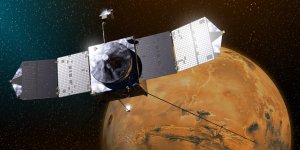| News / Space News |
Making Oxygen on Mars
Science, Space, News
Crazy Engineering explores a technology demonstration riding aboard NASA’s Mars 2020 rover that's straight out of science fiction novels like "The Martian." It's an oxygen generator called MOXIE, designed to convert carbon dioxide — which constitutes about 96% of the Martian atmosphere — into breathable oxygen.
We've all seen the Martian, and we know we need breathable oxygen to survive on Mars. What's up Watney? It turns out it's a lot better to be able to extract it from the atmosphere of Mars, than bring it with you on the trip over, if you have the technology. Let's see how close we are on this episode of Crazy Engineering.
I'm here with Jim. He's gonna teach us how to get oxygen on the surface of Mars. Jim, can you tell us where we are right now?
Absolutely. This is the JPL. Mars Oxygen In-Situ Resource Utilization Laboratory. We call this the MOXIE lab for short. The MOXIE instrument is a demonstration mission, designed to prove that we can produce pure oxygen on the surface of Mars. If it's successful, NASA may opt to send a dedicated mission to produce oxygen for humans to use in the future.
So how do we make oxygen on the surface of Mars?
It's actually a fairly easy process. Basically what we do is we take Mars atmosphere, we run it into a unit called a solid oxide electrolysis unit, which is basically a fuel cell in reverse.
Wait a second. Reverse fuel cell?!? How does that work?
So, this is a solid oxide electrolysis unit, what happens is we have Mars atmosphere enter in this line, goes into the SOXE unit. It's then heated up to 800 degrees Celsius. We inject energy into the cathode and anode, and then what happens is oxygen is separated from the CO2 and comes out this line over here. This line here is the waste gases, that's leftover from the catalyst process. To test this technology, you're gonna need some Martian atmosphere.
Where on Earth are you gonna find that?
We know the composition of Martian atmosphere. It's 95% CO2 with some trace gases, and there are companies here, on Earth, that will mix that gas for us. We call it Mars mixed gas, and we use it for most of our testing.
Well, what if we land on top of a mountain or down in a valley?
The conditions for extracting oxygen are totally different. We gotta test for all of that. So, the way we test for it is we designed an instrumentation system that covers all of the conditions of the instrument: lower pressures, higher pressures, clogging filters, oxygen purity, all of that stuff.
Why don't we just bring the oxygen with us when we go to Mars? It's very difficult to bring something from the surface of the earth to the surface of Mars, and it costs millions and millions of dollars. So, it's much easier and better for us, if we try to get that resource from the planet. Well it's obviously a huge challenge, but we're both really optimistic up here.
We're excited to see it on the Mars 2020 mission, check back soon for some more Crazy Engineering. Heads up Watney.
Credit: NASA Jet Propulsion Laboratory
Country of origin: United States
Language: English
Published on: Jun 12, 2019
YOU MAY ALSO LIKE





